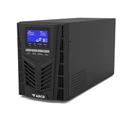There are three general categories of modern UPS systems: on-line, line interactive or standby/offline.
A standby/offline UPS system the load is powered directly by the input power and the backup power circuitry is only invoked when the utility power fails. Most UPS below 1 kVA are of the line-interactive or standby variety which are usually less expensive.
A line interactive UPS maintains the inverter in line and redirects the battery’s DC current path from the normal charging mode to supplying current when power is lost.
An on-line UPS uses a “double conversion” method of accepting AC input, rectifying to DC for passing through the rechargeable battery (or battery strings), then inverting back to 120V/240V AC for powering the protected equipment.
For large power units, dynamic uninterruptible power supplies are sometimes used. A synchronous motor/alternator is connected on the mains via a choke. Energy is stored in a flywheel. When the mains power fails, an Eddy-current regulation maintains the power on the load. DUPS are sometimes combined or integrated with a diesel-generator[clarification needed], forming a diesel rotary uninterruptible power supply, or DRUPS.
A fuel cell UPS has been developed in recent years using hydrogen and a fuel cell as a power source, potentially providing long run times in a small space.






